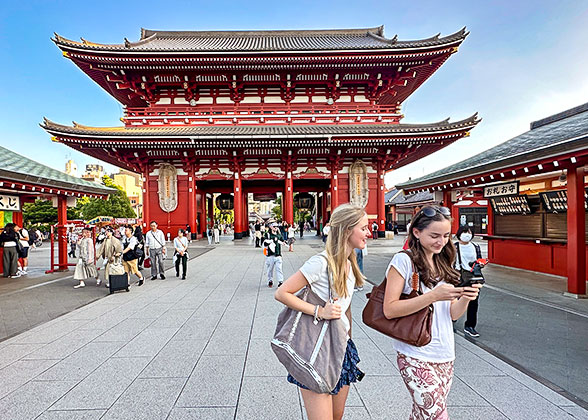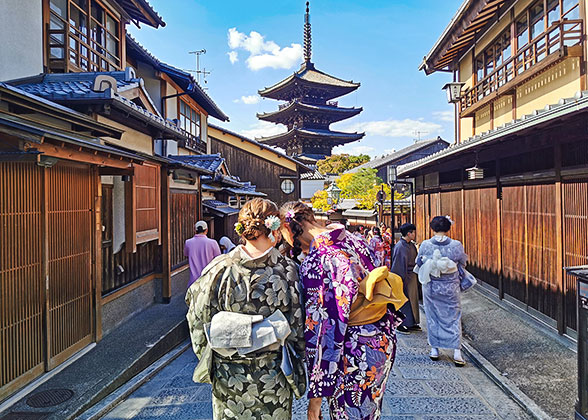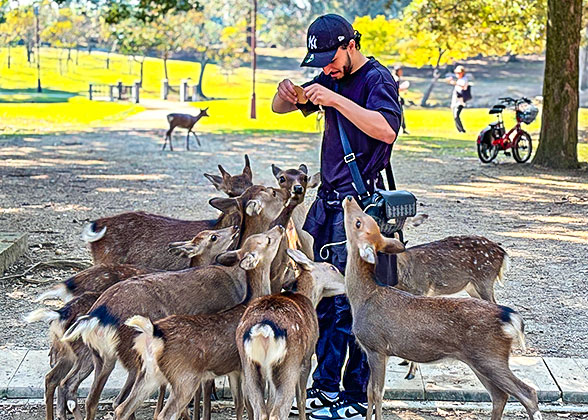Nagoya Weather
![]() Climatic Zones: humid subtropical monsoon climate zone
Climatic Zones: humid subtropical monsoon climate zone
 Climate Feature: four distinct seasons, abundant rainfall
Climate Feature: four distinct seasons, abundant rainfall
 What is the weather in Nagoya like?
What is the weather in Nagoya like?
Nagoya has four distinct seasons in terms of the temperature difference throughout the year: hot summer, cold winter and relatively pleasant spring and autumn. The annual average temperature is 1-32℃ (33.8-89.6℉). Compared with other cities on the Pacific coast, Nagoya has more intensifying temperature variations between its coldest and warmest days, and it can get hot or cold quickly. It is recommended to check local weather forecast before setting out and pack the luggage according to its climate conditions.
Nagoya receives abundant rainfall throughout the year. The annual precipitation is about 1,300-1,600mm (51.2-62.9in). It rains the most during the plum rainy season of around mid-June to mid-July. Typhoons occasionally land here from June to August.
 Warmest Month: August: 25-32℃ (77-89.6℉)
Warmest Month: August: 25-32℃ (77-89.6℉)
 Coolest Month: January: 1-9℃ (33.8-48.2℉)
Coolest Month: January: 1-9℃ (33.8-48.2℉)
According to the following factors, it is best to visit Nagoya in March to May in spring, and October and November in autumn.
 Pleasant weather: The weather is pleasant with moderate temperature and precipitation in the above two time periods, which is suitable for outdoor activities.
Pleasant weather: The weather is pleasant with moderate temperature and precipitation in the above two time periods, which is suitable for outdoor activities.
 Stunning scenery: In spring, cherry blossoms are in full bloom everywhere; in October and November, visitors can enjoy the red autumnal leaves all over the mountains.
Stunning scenery: In spring, cherry blossoms are in full bloom everywhere; in October and November, visitors can enjoy the red autumnal leaves all over the mountains.
 Abundant cultural activities: In the two periods, a variety of celebrations of traditional festivals are held in this city, such as the Parade of Local Heroes, from which visitors can learn more about Japanese culture and history.
Abundant cultural activities: In the two periods, a variety of celebrations of traditional festivals are held in this city, such as the Parade of Local Heroes, from which visitors can learn more about Japanese culture and history.
See more: Best Time to Visit Japan & Japan Weather
|
|
|




Spring: March to May
 Average Temperature: 5-23℃ (41-73.4℉)
Average Temperature: 5-23℃ (41-73.4℉) Precipitation: 403mm (15.9in), falling on 28 days
Precipitation: 403mm (15.9in), falling on 28 days Clothes to Wear: knitwear, hoodie, jeans, trench coat, thick overcoat for cold nights, sneakers
Clothes to Wear: knitwear, hoodie, jeans, trench coat, thick overcoat for cold nights, sneakers Weather:
Weather: The temperature gradually rises in spring, the highest of which can reach more than 20℃ (68℉). But there is a large temperature difference between day and night. It is relatively warm in the sun during the day while it gets cold after dark. It has moderate precipitation of 403mm (15.9in), falling on around 28 days. Cherry blossoms are in full bloom from late March to early April, creating a unique natural landscape. The pleasant weather condition and stunning natural scenery in this season make it one of the best times to visit Nagoya.
 Best Things to Do:
Best Things to Do:1. Enjoy blossoming cherry flowers in Nagoya Castle. It is one of the most beautiful cherry blossom sceneries in Nagoya. You will get an unforgettable visiting experience when the lights in the castle are on at night.
2. Visit Atsuta Jingu Shrine to experience the culture of Shinto in Japan. It is one of the oldest shrines in Japan. You can buy an amulet and write wishing notes there.
 Tips:
Tips:1. If you have a pollen allergy, remember to wear masks during the journey and pack allergy medicine in your suitcase for an emergency.
2. It can be cold at night, so it is recommended to add a thick coat for keeping warm.

Blooming Cherry Blossoms in Nagoya Castle
|
Summer: June to August
 Average Temperature: 20-32℃ (68-89.6℉)
Average Temperature: 20-32℃ (68-89.6℉) Precipitation: 531mm (20.9in), falling on 32 days
Precipitation: 531mm (20.9in), falling on 32 days Clothes to Wear: short-sleeve T-shirt, shorts, summer dress, sandals
Clothes to Wear: short-sleeve T-shirt, shorts, summer dress, sandals
 Weather:
Weather:
Summer is hot in Nagoya. Besides, the plum rainy season lasts from mid-June to mid-July. During this period, it rains almost every day, leading to humidity to rise. The total rainfall can reach more than 531mm (20.9in) on average, which is the most of the year. On rainy days, it is often humid, making people feel a bit uncomfortable. After the plum rainy season, the temperature rises dramatically, making Nagoya one of the hottest cities in Japan. Besides, typhoons often land in Nagoya in summer, which may cause heavy rainfall and landfall. If you schedule your trip in this season in 2026, remember to pay attention to the weather forecast in time.
See more: Everything You Need to Know about Rainy Season in Japan
 Best Things to Do:
Best Things to Do:1. Watch grand fireworks shows in Port of Nagoya. Local people celebrate the fireworks festivals from July to August.
2. Enjoy yourself in Atsuta Festival on June 5 in Atsuta Jingu Shrine. Many people wear kimonos and hold fans in their hands. There are various performances including kendo, archery, and ikebana on that day.
3. Explore the “World of Anime” on Nagoya streets. The World Cosplay Summit held here from late July to early August every year attracts many cosplay fans. You will see people parading in cosplay costumes everywhere.
 Tips:
Tips:1. Considering the strong sunlight of summer, it is advised to pack enough sun protection items including the sunscreen cream, sunglasses, and sunhats.
2. Remember to pack raingear such as raincoats and umbrellas to deal with continuous rainy days in the plum rainy season.

Lively Atsuta Jingu Shrine
|
Autumn: September to November
 Average Temperature: 9-28℃ (48.2-82.4℉)
Average Temperature: 9-28℃ (48.2-82.4℉) Precipitation: 441mm (17.4in), falling on 25 days
Precipitation: 441mm (17.4in), falling on 25 days Clothes to Wear: long-sleeve T-shirt, jeans, long-sleeve dress, trench coat, casual shoes
Clothes to Wear: long-sleeve T-shirt, jeans, long-sleeve dress, trench coat, casual shoes Weather:
Weather:After the rainy summer, Nagoya enjoys mild and pleasant climate in autumn, especially in the latter two months of October and November. It is no longer as hot as in summer, and the temperature gradually drops to below 30℃ (86℉), making people feel cool but not cold. The rainfall is relatively moderate. In November, the average monthly precipitation drops to 80mm (3.1in) with 6 rainy days, which is suitable for outdoor explorations.
 Best Things to Do:
Best Things to Do:1. Watching the celebrations of Nagoya Festival such as the “Parade of Local Heroes” in mid-October.
2. Appreciate the beauty of red autumnal leaves in Tokugawa Garden and Nagoya Castle. It is the best time to enjoy unique autumn scenery.
3. Visit LEGOLAND Japan Resort, a paradise for Lego lovers. You will find miniature Lego models of famous spots and cities in Japan.
4. Visit the Toyota Commemorative Museum of Industry and Technology where you can learn much about the production and manufacturing of Toyotas.

Colorful Autumn Scene
|
Winter: December to February
 Average Temperature: 1-11℃ (33.8-51.8℉)
Average Temperature: 1-11℃ (33.8-51.8℉) Precipitation: 159mm (6.3in), falling on 17 days
Precipitation: 159mm (6.3in), falling on 17 days Clothes to Wear: wool sweater, fleece hoodie, winter pants, down coat, sneakers, boots
Clothes to Wear: wool sweater, fleece hoodie, winter pants, down coat, sneakers, boots Weather:
Weather:Actually, it is not advisable to travel to Nagoya in winter because its temperature often remains below 10℃ (50℉). In January 2024, the lowest temperature even dropped below 0℃ (32℉). It also has strong wind, making people feel exceptionally cold. If you are preparing to have a trip in winter, remember to pack warm clothes to avoid catching a cold. Winter is the driest season of the year. It rains or snows a little, with a total precipitation of 159mm (6.3in) on average. Most days of the month are sunny, so you will not be bothered by endless rainy days.
 Best Things to Do:
Best Things to Do:1. Admire the night view from the viewing platform of Nagoya Port. You will see the illuminated port and the magnificent scene of the whole city.
2. Visit the Osu Kannon Temple and learn about Japanese Buddhist culture.
3. Watch the wonderful animal performances in the Port of Nagoya Public Aquarium. You can have interaction with sea animals and be closer to them than ever before.

Osu Kannon Temple in Winter
|
You May Like
-
 10 Days Private Tour of Tokyo - Mt. Fuji - Nagoya - Takayama - Shirakawa-go - Kanazawa - Kyoto - Nara - Hiroshima - Osaka from USD3809
10 Days Private Tour of Tokyo - Mt. Fuji - Nagoya - Takayama - Shirakawa-go - Kanazawa - Kyoto - Nara - Hiroshima - Osaka from USD3809 -
 7 Days Mini Group Tour with Highlights in Japan: Tokyo - Mt. Fuji - Kyoto - Nara - Osaka from USD2155
7 Days Mini Group Tour with Highlights in Japan: Tokyo - Mt. Fuji - Kyoto - Nara - Osaka from USD2155 -
 8 Days Japan Mini Group Tour to Tokyo - Hakone & Mt. Fuji - Kyoto - Nara - Osaka - Hiroshima - Osaka from USD2771
8 Days Japan Mini Group Tour to Tokyo - Hakone & Mt. Fuji - Kyoto - Nara - Osaka - Hiroshima - Osaka from USD2771


